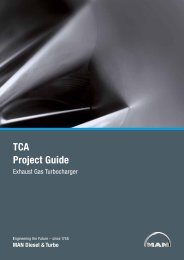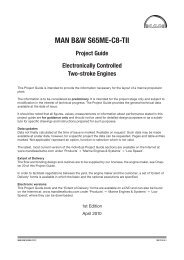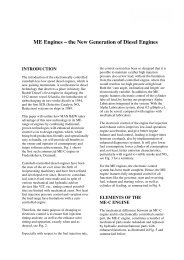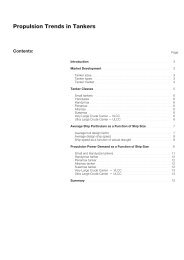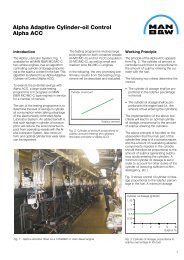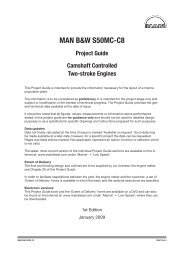Image Study Diesel Power Plants - MAN Diesel & Turbo
Image Study Diesel Power Plants - MAN Diesel & Turbo
Image Study Diesel Power Plants - MAN Diesel & Turbo
Create successful ePaper yourself
Turn your PDF publications into a flip-book with our unique Google optimized e-Paper software.
<strong>Image</strong> <strong>Study</strong><br />
6. SUB-HYPOTHESIS 2:<br />
ENGINE TECHNOLOGY AND ENVIRONMENTAL AWARENESS ARE<br />
COMPATIBLE<br />
Of all four sub-hypotheses examined in this<br />
study, this one probably creates the widest<br />
platform for discussion. That might be due to<br />
the fact that people think of fuming old and<br />
greasy motors when thinking about <strong>Diesel</strong><br />
engines or engine-based technology in general.<br />
To find out if this picture is actually justified and<br />
to shed some light on this topic in general, the<br />
following paragraphs have a closer look from<br />
an externality perspective.<br />
Externalities, or external costs, arise when the<br />
social or economic activities of one group or<br />
persons have an impact on another group and<br />
when that impact is not fully accounted, or<br />
compensated for, by the first group. Measuring<br />
and analyzing externalities is an often-<br />
discussed and very complex subject. The<br />
concept is deeply anchored in economic theory<br />
and is becoming increasingly important when<br />
evaluating different sources of energy.<br />
The main damages caused by externalities<br />
effect human health, crops, materials and the<br />
environment in general. And while this subject<br />
can be analyzed in many different ways, we<br />
chose to focus on two distinct areas to analyze<br />
the statement that engine-based technology<br />
and environmental awareness can be<br />
compatible. On the following pages we will<br />
have a closer look at CO2 emissions and the<br />
consumption of water. The second section<br />
within this paragraph will focus on fuel<br />
versatility and combined renewable and<br />
engine-based power plants, all within the<br />
context of sub-hypothesis 2.<br />
Carbon Dioxide Emissions<br />
Today, the significant negative impact of<br />
carbon dioxide (CO2) emissions on our climate<br />
is widely known. In most developed countries,<br />
the largest source of CO2 emissions is the<br />
combustion of fossil fuels. And the process of<br />
generating electricity usually tops the list in this<br />
category, making it the single largest source of<br />
those emissions.<br />
Carbon dioxide emissions are always<br />
dependent on the carbon content of the fuel<br />
and the efficiency of the technology being used.<br />
Table 1 gives an overview of the carbon<br />
dioxide emissions of typical fossil-based power<br />
plants that are generated during the electricity<br />
production process and also puts the<br />
emissions in context with the respective plant<br />
efficiencies (generally based on state-of-the-art<br />
technology).<br />
17



